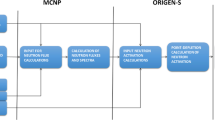The classification used during the decommissioning of nuclear installations for the activated materials of radiation protection made of concrete is validated. It is shown that in the decommissioning of nuclear installations the category of activated wastes that are formed, including owing to the large and sometimes determining contribution of 3H in the total induced activity of the concrete with decay times up to 100 years, can be interpreted loosely. The requirements of handling tritium-containing wastes have not been developed.
Similar content being viewed by others
References
I. A. Engovatov, V. P. Mashkovich, Y. V. Orlov, et al., Radiation Safety Assurance: Decommissioning Nuclear Reactors at Civil and Military Installations, Monographia, Arlington, USA (2005).
B. K. Bylkin and I. A. Engovatov, Decommissioning of Reactor Installations, MGSU, Moscow (2014).
Decommissioning of Nuclear Power Plants and Research Reactors, IAEA Saf. Standards, Ser. No. WS-G-2.1, IAEA, Vienna (1999).
T. Yu. Aliev, I. A. Engovatov, P. A. Lavdanskii, and V. N. Solov’ev, “Induced activity of radiation-protective concrete in cyclotron canyons at the decommissioning stage,” Vest. MGSU, No. 10, 106–113 (2014).
B. K. Bylkin, G. B. Davydova, and E. A. Zhurbenko, “Radioactive waste in dismantling of reactor installations,” At. Energ., 110, No. 3, 171–172 (2011).
E. Ivanov, A. Korotkov, and I. Pyrkov, “Radionuclide vector,” Byull. Rosenergoatoma, No. 1, 42–45 (2015).
J. Evans, E. Lepel, R. Sundens, et al. “Long-lived activation products in light-water reactor construction materials: implication for decommissioning,” in: Radioactive Waste Management and the Nuclear Fuel Cycle (1988), Vol. 11(1), pp. 1–39.
B. K. Bylkin, I. A. Engovatov, and A. N. Kozhevnikov, “Choice of concrete radiation shielding for next-generation nuclear power plants,” At. Energ., 118, No. 6, 350–354 (2015).
I. A. Engovatov, B. K. Bylkin, and A. N. Kozhevnikov, “Optimization of the compositions of concrete for radiation protection of NPP,” in: 9th Int. Sci. Tech. Conf. on the Safety, Effi ciency, and Economy of Nuclear Power, MNTK-2014, Moscow (2014), pp. 305–309.
B. K. Bylkin, V. N. Grebennik, I. M. Ibragimov, and A. A. Khrulev, “Power-technology applications of nuclear reactors,” Itogi Nauki i Tekhn. Ser. At. Energet., VINITI, 6, 140 (1988).
Author information
Authors and Affiliations
Additional information
Translated from Atomnaya Énergiya, Vol. 121, No. 5, pp. 298–301, November, 2016.
Rights and permissions
About this article
Cite this article
Bylkin, B.K., Kozhevnikov, A.N., Engovatov, I.A. et al. Radioactivity Category Determination for Radiation-Protection Concrete in Nuclear Facilities Undergoing Decommissioning. At Energy 121, 383–387 (2017). https://doi.org/10.1007/s10512-017-0216-1
Received:
Published:
Issue Date:
DOI: https://doi.org/10.1007/s10512-017-0216-1




